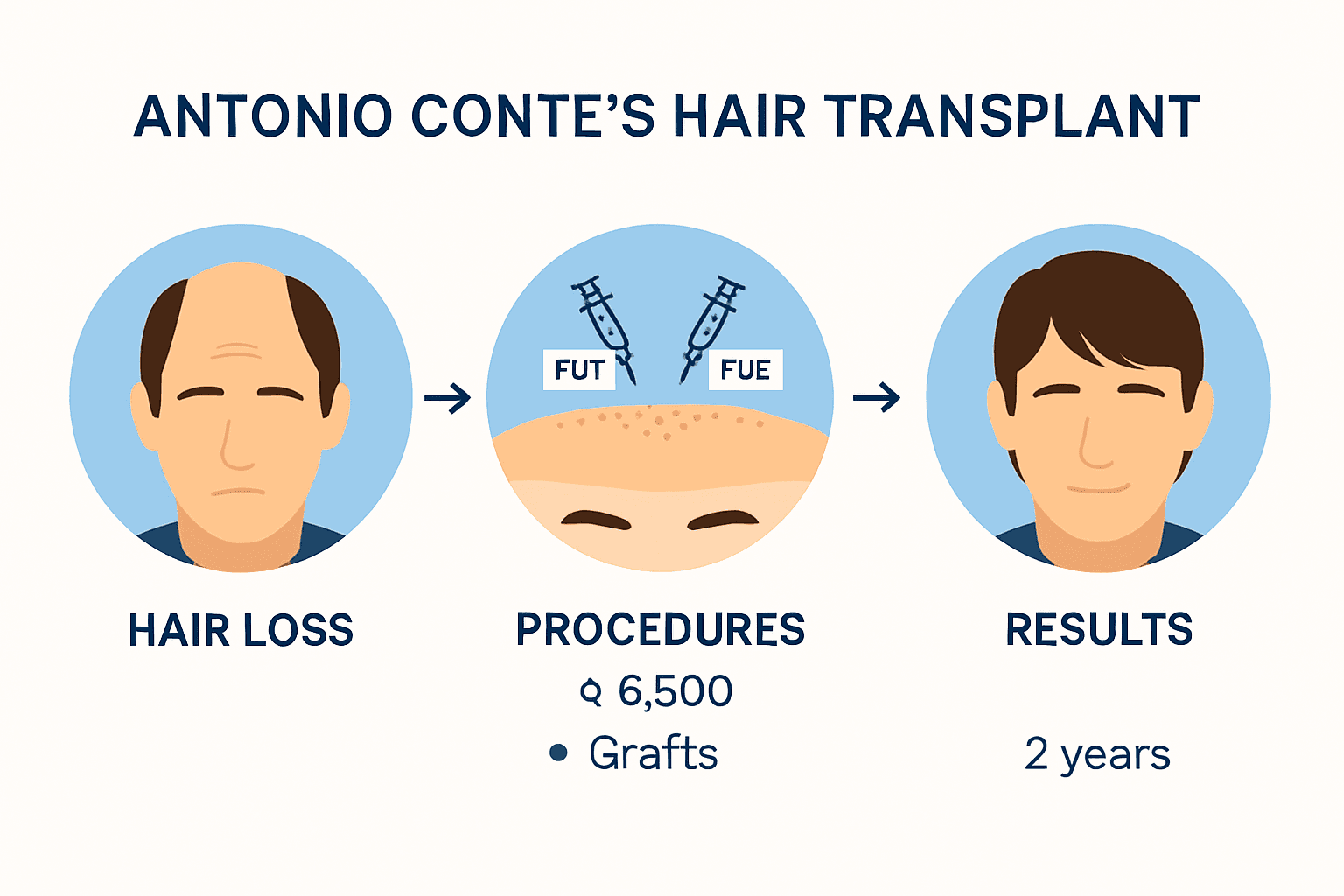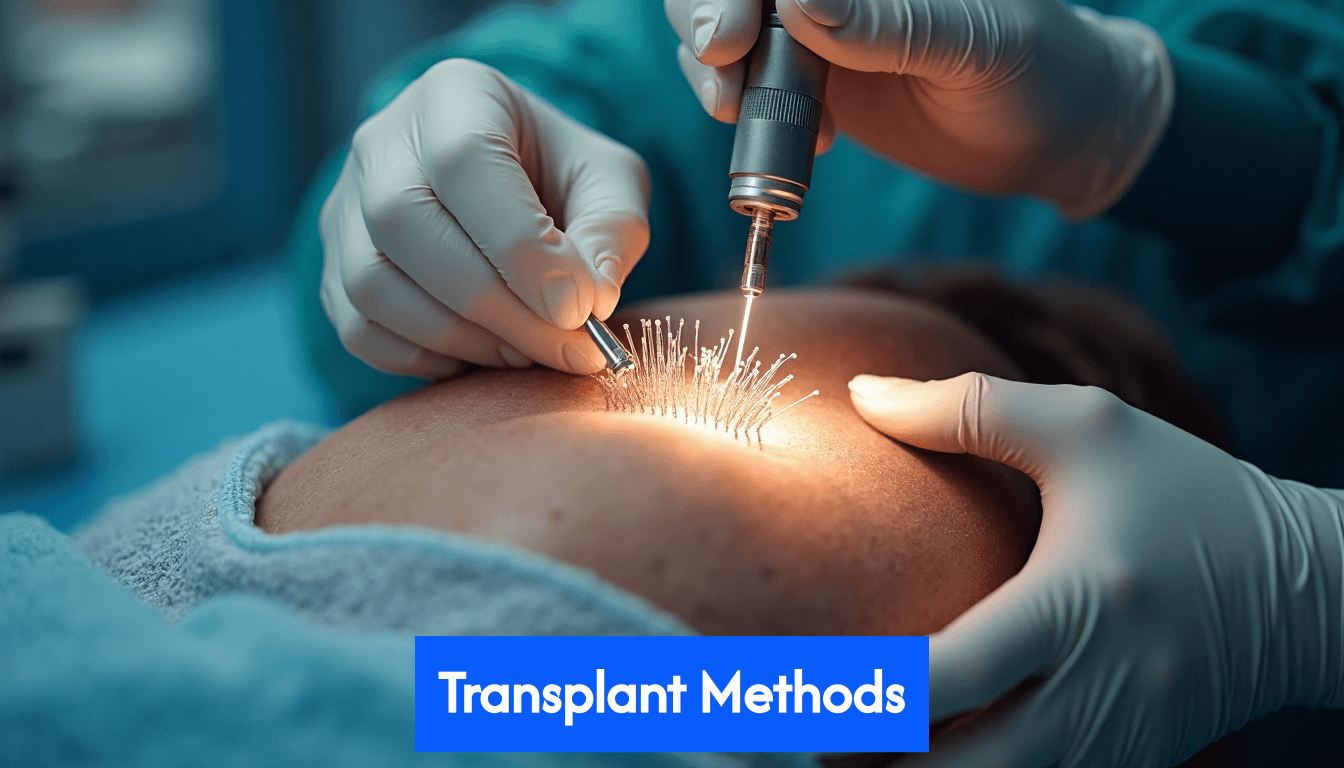Blog
Learning Materials
Conte Hair Transplant Guide 2025: Results, Methods & Aftercare
Updated: June 23, 2025

Antonio Conte’s hair caught worldwide attention, but not for the reasons you might expect. In 2025, hair transplant techniques have surged ahead, and Conte’s results showcase just how remarkable things can get. Modern hair transplants now offer a typical 70-90 percent graft survival rate and progress over 8 to 12 months for full, natural results. Here’s what most people miss. The real transformation goes far beyond new hair—today’s methods blend cutting-edge tech, skilled artistry, and ongoing aftercare that keeps those results thriving years down the line.
Table of Contents
- Understanding Conte's Hair Transplant Journey
- Latest Hair Transplant Methods For 2025
- Realistic Results And What To Expect
- Personalized Hair Care And Recovery Tips
Quick Summary
| Takeaway | Explanation |
|---|---|
| Follicular Unit Extraction (FUE) | FUE is the leading hair transplant technique in 2025, known for minimal scarring and faster recovery. It uses advanced precision mapping and AI-assisted technology for optimal results. |
| Realistic Expectations for Recovery | Hair transplant results develop progressively over 8 to 12 months. Initial shedding, followed by new growth, is part of the natural process, with full results visible after about one year. |
| Tailored Aftercare Strategies | The first week post-surgery is crucial; gentle scalp care, restricted activities, and following medical advice can significantly impact graft survival and overall success. |
| Long-Term Hair Maintenance | To sustain transplant results, ongoing care including regular scalp assessments, a balanced diet, stress management, and periodic consultations with specialists is essential. |
| Consultation with Professionals | Engaging with qualified hair restoration specialists before and after the procedure is vital for personalized insights and optimal outcomes tailored to individual needs. |
Understanding Conte's Hair Transplant Journey
Hair loss is a challenging experience for many, and public figures like Antonio Conte have brought transparency to hair restoration techniques. Conte's personal journey illustrates the advanced possibilities of modern hair transplant procedures, offering hope and insights for individuals experiencing similar challenges.
The Initial Hair Loss Challenge
Antonio Conte's hair loss journey began with noticeable thinning that impacted his confidence. Before his transplant, the renowned football manager experienced significant hair recession typical of male pattern baldness. His decision to pursue a hair transplant was not just about aesthetics but about restoring self-assurance in a high-profile professional environment.
Surgical Transformation and Technique
According to specialized hair restoration clinics, Conte underwent multiple procedures to achieve his desired results. His initial treatments in Italy used the Follicular Unit Transplantation (FUT) technique, which proved less satisfactory. The breakthrough came with a third procedure in Vancouver, utilizing the advanced Follicular Unit Extraction (FUE) method. This technique allowed for precise graft placement with minimal scarring.
The procedure involved transplanting approximately 4,500 to 5,000 grafts, a significant intervention that dramatically improved hair density. Hair restoration experts note that the success of Conte's transplant stems from the precision of the FUE technique and the skill of the surgical team.

Recovery and Long-Term Results
Conte's hair transplant journey demonstrates that modern techniques offer more than temporary solutions. The transplanted hair grows naturally, blending seamlessly with existing hair. Over 8 to 12 months, patients can expect progressive improvement in hair density and coverage. For those considering similar procedures, our guide on natural hair growth solutions provides additional insights into comprehensive hair restoration strategies.
While Conte's experience highlights the potential of hair transplant technologies, individual results can vary. Factors like age, hair quality, and overall health play crucial roles in the success of such procedures. Consulting with qualified professionals and understanding personal hair loss patterns remain essential steps in any hair restoration journey.
Latest Hair Transplant Methods for 2025
Hair transplant technologies continue to evolve rapidly, offering increasingly sophisticated solutions for individuals experiencing hair loss. In 2025, multiple advanced techniques have transformed the landscape of hair restoration, providing patients with more precise, minimally invasive, and natural-looking options.
Precision-Driven Follicular Unit Extraction (FUE)
Follicular Unit Extraction remains the gold standard in hair transplantation for 2025. Advanced hair restoration clinics now incorporate artificial intelligence and robotic technologies to enhance graft harvesting and placement. The FUE method continues to excel by offering minimal scarring, faster recovery times, and remarkably natural results.
Key advantages of modern FUE include:
- Minimal Invasiveness: Smaller incisions reducing healing time
- Precision Mapping: AI-assisted follicle selection and extraction
- Natural Hair Growth: Seamless integration with existing hair
Innovative Direct Hair Implantation (DHI)
Direct Hair Implantation has emerged as a groundbreaking technique in 2025. Using a specialized implanter pen, DHI allows for direct graft placement with unprecedented accuracy. Hair restoration experts highlight its ability to achieve higher graft survival rates and significantly reduced healing periods.
The DHI technique offers unique benefits:
- Immediate Implantation: Grafts transferred directly without external storage
- Higher Survival Rates: Reduced time between extraction and reimplantation
- Customized Angle Control: Precise hair direction and natural appearance
Robotic Hair Transplant Systems
Robotic technologies like ARTAS iX represent the cutting edge of hair restoration in 2025. These systems provide unparalleled precision through advanced imaging and automated extraction techniques. Technological research indicates robotic systems can dramatically reduce human error and optimize graft placement.

For those interested in comprehensive hair health strategies, our expert guide on natural hair growth offers additional insights into maintaining robust hair quality. The integration of these advanced transplant methods with holistic hair care approaches represents the future of personalized hair restoration.
Patients considering hair transplants in 2025 should consult qualified professionals who specialize in these emerging technologies. Each technique offers unique advantages, and the most suitable method depends on individual hair loss patterns, scalp condition, and personal aesthetic goals. The ongoing technological advancements promise increasingly natural, effective, and personalized hair restoration solutions.
Realistic Results and What to Expect
Understanding the potential outcomes of a hair transplant is crucial for managing expectations and preparing for a successful restoration journey. In 2025, advanced techniques provide patients with increasingly natural and predictable results, though individual experiences can vary significantly based on multiple factors.
Timeline of Hair Restoration
A successful hair transplant is not an overnight transformation. Hair restoration experts indicate that patients can expect a progressive improvement over 8 to 12 months. The initial weeks after the procedure involve several critical stages:
- Immediate Post-Procedure: Minor redness and potential scabbing
- First Month: Initial shedding of transplanted hair is normal
- 3-6 Months: New hair growth begins to emerge
- 9-12 Months: Full, natural-looking results become visible
Factors Influencing Transplant Success
Advanced hair clinics emphasize that realistic results depend on several key factors. The quality of donor hair, patient's age, overall health, and the specific technique used dramatically impact the final outcome. Modern FUE techniques using sapphire blades and robotic assistance have significantly improved precision and natural appearance.
Important considerations include:
- Donor Hair Quality: Thickness and density of existing hair
- Scalp Condition: Overall health and healing potential
- Age and Hormonal Factors: Impact hair growth and transplant success
- Surgical Technique: Precision of graft placement
Managing Expectations and Long-Term Care
Patients should understand that while modern techniques offer remarkable results, a hair transplant is not a permanent solution to hair loss. Comprehensive hair health strategies play a crucial role in maintaining and enhancing transplant results. The most successful outcomes combine advanced surgical techniques with ongoing hair care and potential supplementary treatments.
Key expectations include:
- 70-90% Graft Survival Rate: Typical success range for modern techniques
- Natural Appearance: Undetectable transplant results
- Potential Future Procedures: Ongoing management may be necessary
Consultation with a qualified hair restoration specialist remains the most critical step. They can provide personalized insights based on individual hair loss patterns, scalp condition, and aesthetic goals. While celebrity cases like Antonio Conte demonstrate the potential of modern hair transplant techniques, each patient's journey is unique.
Ultimately, realistic expectations, proper aftercare, and a holistic approach to hair health are the cornerstones of a successful hair restoration experience. Patients should approach the procedure with patience, understanding that natural-looking results take time to fully develop and require ongoing care and attention.
Personalized Hair Care and Recovery Tips
Successful hair transplant recovery extends far beyond the surgical procedure. In 2025, personalized care and strategic post-operative management are crucial for maximizing transplant results and ensuring long-term hair health. Each patient's recovery journey requires a tailored approach that considers individual healing capabilities and specific procedural nuances.
Critical First Week Recovery Strategy
Hair transplant specialists emphasize the importance of the initial recovery phase. The first week is pivotal in determining long-term graft survival and overall restoration success. Key recommendations include:
- Gentle Scalp Management: Avoid direct touching or scratching of transplanted areas
- Elevated Sleeping Position: Use additional pillows to reduce swelling
- Minimal Physical Activity: Restrict intense exercises and sweating
- Medication Adherence: Follow prescribed anti-inflammatory and healing medications
Specialized Aftercare Protocols
Advanced hair restoration clinics recommend comprehensive aftercare strategies tailored to individual patient needs. This includes specialized hair care products, precise cleaning techniques, and protective measures to support graft integration and minimize potential complications.
Critical aftercare components include:
- Specialized Cleansing: Use recommended gentle, sulfate-free shampoos
- Sun Protection: Avoid direct sunlight for initial recovery period
- Medication Support: Consider supplementary treatments like Finasteride
- Hydration and Nutrition: Support healing through balanced diet
Long-Term Hair Health Maintenance
Beyond immediate recovery, sustaining transplant results requires a holistic approach. Our comprehensive guide on natural hair products offers insights into maintaining hair quality and supporting ongoing hair health. Strategic long-term care involves multiple considerations:
- Regular Scalp Assessments: Monitor transplant area and overall hair condition
- Nutritional Support: Incorporate hair-strengthening nutrients
- Stress Management: Recognize stress's impact on hair health
- Continuous Professional Consultation: Schedule periodic check-ups
Patients should understand that recovery is a personalized journey. While general guidelines provide a framework, individual variations in healing, hair type, and overall health necessitate customized approaches. Communication with hair restoration professionals remains paramount in navigating post-transplant care.
Ultimately, successful hair transplant recovery in 2025 combines advanced medical techniques with patient-specific care strategies. By embracing a comprehensive, individualized approach, patients can optimize their restoration results and achieve long-lasting, natural-looking hair growth.
Frequently Asked Questions
What is the typical timeline for hair transplant results?
Hair transplant results typically develop over 8 to 12 months. Initial shedding may occur after the procedure, followed by new hair growth, with full results visible around one year.
What are the latest hair transplant methods in 2025?
In 2025, the leading hair transplant techniques include Follicular Unit Extraction (FUE), Direct Hair Implantation (DHI), and robotic hair transplant systems, each offering unique benefits for precision and natural results.
How can I ensure the success of my hair transplant?
To ensure the success of your hair transplant, follow post-operative care guidelines, maintain realistic expectations, and consult with a qualified specialist for personalized insights based on your specific hair loss patterns.
What should I expect during the recovery period after a hair transplant?
During the recovery period, expect minor redness and scabbing initially. It's crucial to manage your scalp gently, avoid intense physical activity, follow prescribed medications, and adhere to aftercare protocols for optimal graft survival.
Ready for Hair Like Conte? Personalize Your Path to Fuller Growth
Tired of struggling with thinning hair or unsure if a hair transplant is right for your unique needs? The "Conte Hair Transplant Guide 2025" highlights just how much today’s technology has advanced. But the real challenge remains in understanding your personal hair loss patterns, predicting your recovery timeline, and finding solutions tailored to you—not just generic advice. Many readers fear wasting time or money on treatments that do not match their specific situation. Confidence can take a big hit when progress feels uncertain.

Why leave your results to chance? Unlock your personalized hair health assessment powered by AI with MyHair.ai. Upload a scan to analyze your unique hair growth patterns, track changes over time, and get product recommendations designed just for you. The journey to natural and lasting hair restoration starts with clear insight and a plan tailored to your needs. Visit MyHair.ai now to take control of your hair story and see what your future growth could look like. Act today to turn expert advice into confidence and results you can see.